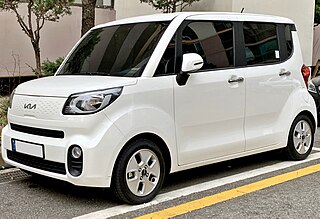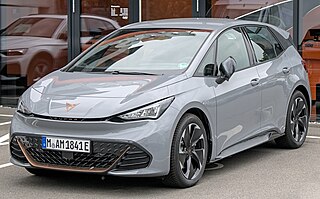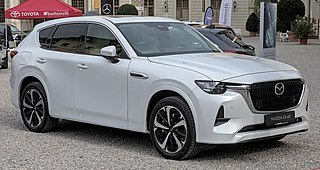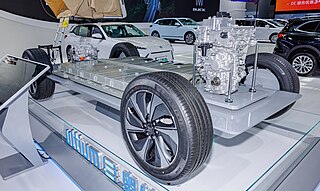
The Toyota RAV4 EV is an all-electric version of the popular RAV4 SUV produced by Toyota until 2014. Two generations of the EV model were sold in California, and to fleets elsewhere in the US, with a gap of almost ten years between them.

The Honda EV Plus was an experimental electric vehicle which was the first battery electric vehicle from a major automaker that did not use lead acid batteries. Roughly 340 EV Plus models were produced and released. Production of the EV Plus was discontinued in 1999 after Honda announced the release of its first hybrid electric vehicle, the Honda Insight.
MIEV (Mitsubishi In-wheel motor Electric Vehicle) or MiEV (Mitsubishi innovative Electric Vehicle) is the name given by Japanese automaker Mitsubishi Motors (MMC) to its alternative propulsion technologies. From late 2006, “MiEV” encompasses all of Mitsubishi Motors’s electric drive systems work, including lithium-ion batteries, in-wheel motors and other technologies related to electric vehicle (EV), hybrid-electric vehicle and fuel-cell vehicles.
Skyactiv is a brand name for a series of automobile technologies developed by Mazda that increase fuel efficiency and engine output. The initial announcement of the Skyactiv technologies included new engines, transmissions, body, and chassis, which appeared in Mazda products from 2011 onwards.

The Kia Ray is a city car manufactured by Kia exclusively for the South Korean domestic market. Based on the Kia Picanto/Morning, it was specifically developed in compliance with the "light car" category that offers tax incentives for cars with exterior dimensions below 3,600 mm (141.7 in) in length and below 1,600 mm (63.0 in) in width.

The Hyundai Ioniq is a compact five-door liftback manufactured and marketed by Hyundai. The nameplate Ioniq is a portmanteau of ion and unique. It is marketed as the first Hyundai automobile to be offered without a standard internal combustion engine, but rather sold in hybrid, plug-in hybrid, and all-electric variants.

The Lucid Air is a battery electric 4-door luxury sedan made by Lucid Motors. Announced in December 2016 and sold starting in 2021, it is designed to compete with the Tesla Model S, the Porsche Taycan, as well as other luxury battery electric vehicles made by Mercedes-Benz, BMW and Audi.

The Hyundai Kona is a subcompact crossover SUV produced by the South Korean manufacturer Hyundai. The first-generation Kona debuted in June 2017 and the production version was revealed later that year. It is positioned between the Venue or Bayon and the Tucson in Hyundai crossover SUV line-up. The battery electric version called the Kona Electric was first launched in South Korea during the first half of 2018 and rolled out gradually worldwide afterwards.

The BMW i4 is a battery electric compact executive car produced by BMW since 2021. It adopts a five-door liftback body style and is marketed as a four-door coupé. The initial concept version, named BMW i Vision Dynamics, debuted at the 2017 Frankfurt Motor Show. It is the fifth BMW i sub-brand model, and is sold in several variants at different performance levels, including the first battery-electric variant by BMW's motorsport division. The production version was revealed in March 2021 and went on sale in November of the same year as a 2022 model.

The Audi Q8 e-tron is a battery electric mid-size luxury crossover produced by Audi since 2019. The e-tron was unveiled as a concept car at the 2015 Frankfurt Motor Show. The final production version was revealed in San Francisco on 17 September 2018, publicly debuted at the 2018 Paris Motor Show, and was first delivered in May 2019. It is the company's first battery electric mass production car. The Sportback variant, a coupe style of the e-tron, entered production in 2020.

The Mazda MX-30 is a subcompact crossover SUV produced by Mazda and sold as a battery electric (BEV), plug-in hybrid (PHEV) or mild hybrid (MHEV) variant. Based on the CX-30, it was unveiled at the 2019 Tokyo Motor Show. Production of the vehicle, which is Mazda's first mass-produced electric car, began at their Ujina factory on 19 May 2020.

The Ford Mustang Mach-E is a battery electric compact crossover SUV produced by Ford. Introduced on November 17, 2019, it went on sale in December 2020 as a 2021 model. The Mach-E is part of the Mustang series, with its name inspired by the Mach 1 variant of the first-generation Mustang. The car won the 2021 North American SUV of the Year Award.

The Volkswagen ID.4 and Volkswagen ID.5 are battery electric compact crossover SUVs produced by Volkswagen. Based on the MEB platform, the ID.4 is the second model of the Volkswagen ID. series. The production version of the ID.4 debuted in September 2020 as the first fully-electric crossover SUV under the Volkswagen brand, while the coupe-shaped variant of the ID.4 is marketed as the Volkswagen ID.5 and was revealed in November 2021.

The Cupra Born is a battery electric compact car/small family car (C-segment) marketed by SEAT through its performance-oriented Cupra marque. Initially unveiled as the SEAT el-Born concept in 2019, the production car was revealed in May 2021 as the Cupra Born. The Born is based on the Volkswagen Group MEB platform and has been manufactured at the same plant in Zwickau, Germany, as the MEB-based Volkswagen ID.3. The car is named after a neighbourhood in Barcelona, Catalonia, Spain.

The BYD Han is a full-size / executive sedan (E-segment) manufactured by the Chinese manufacturer BYD Auto since 2020, available in an battery electric variant and a plug-in hybrid (PHEV) variant. It is part of BYD's "Dynasty" series passenger vehicles, and gets its name from the Han Dynasty, the first golden age of Imperial China.

The Hyundai Ioniq 5 is a battery electric compact crossover SUV produced by Hyundai since 2021. It is the first product to be marketed under the electric cars-focused Ioniq sub-brand, and the first model developed on the Hyundai Electric Global Modular Platform (E-GMP).

The Mazda CX-60 is a mid-size crossover SUV produced by the Japanese automobile manufacturer Mazda since 2022. It is the first vehicle to use Mazda's rear- and all-wheel drive platform with longitudinal engine layout categorised as Large Product Group, which includes a line-up of straight-six engines. It is also the first Mazda vehicle to feature a plug-in hybrid option.

Ultium is an electric vehicle battery and motor architecture developed by General Motors. It is being deployed for battery electric vehicles from General Motors portfolio brands along with vehicles from Honda and Acura.

The MG4 EV is a battery electric small family car (C-segment) produced by the Chinese automotive manufacturer SAIC Motor under the British MG marque. First released in June 2022 as the MG Mulan in China, it was introduced in Europe in July 2022.

The Mercedes-Benz Vision EQXX is a battery electric concept car by German carmaker Mercedes-Benz. Unveiled at the 2022 edition of the Consumer Electronics Show, it is a proof of concept, with Mercedes-Benz's primary goal being a target of below 10 kWh per 100 km in real-life conditions. The EQXX's exterior features various stylistic cues that help maximise its aerodynamic efficiency, and numerous eco-friendly materials that adorn the interior. The car's name refers to Mercedes' vision for the future of automobile manufacturing, with Mercedes chairman Ola Källenius stating that the EQXX is "how we imagine the future of electric cars", and that the car "underlines where our entire company is headed".


















